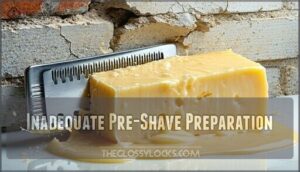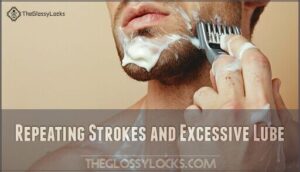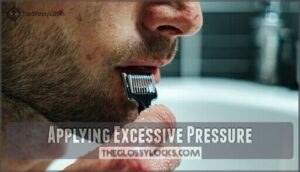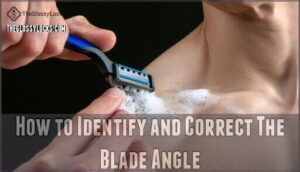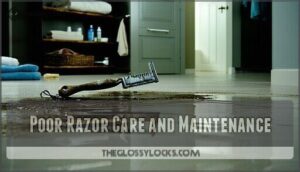This site is supported by our readers. We may earn a commission, at no cost to you, if you purchase through links.
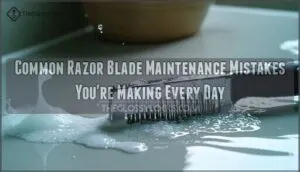
Using dull blades too long creates nicks and irritation, while improper storage leads to rust and corrosion.
Many folks skip essential pre-shave prep, apply excessive pressure, or ignore their razor’s angle—all recipe for disaster.
Poor cleaning habits let bacteria flourish, and using the wrong blade for your skin type guarantees trouble.
Most people also overlook simple protective measures that could extend blade life substantially.
These seemingly minor oversights compound into major shaving headaches, but mastering the fundamentals transforms your routine completely.
Table Of Contents
- Key Takeaways
- Avoiding Dull Razor Blades
- Preventing Razor Rust and Corrosion
- Inadequate Pre-Shave Preparation
- Repeating Strokes and Excessive Lube
- Applying Excessive Pressure
- Using The Wrong Blade Angle
- Poor Razor Care and Maintenance
- Ignoring Skin Type and Needs
- Overlooking Razor Sharpness
- Not Using Protective Measures
- Frequently Asked Questions (FAQs)
- What happens if a razor is clogged?
- How do I know if my razor blade is bad?
- Why do you need a sharp razor blade?
- Should you use a single blade or multi-blade razor?
- How to maintain a clean razor during a shave?
- What should I not do if my razor won’t work?
- How to tell if a razor blade is bad?
- How to maintain a razor blade?
- How many times should a razor blade be used before being replaced?
- Can you clean razor blades of bacteria off?
- Conclusion
Key Takeaways
- You’re keeping dull blades too long – Replace your razor blade every 5-7 shaves to avoid tugging, nicks, and irritation that occur when the cutting edge loses its sharpness.
- You’re not drying your razor properly – Rinse thoroughly after each use, shake out trapped water, and store in a dry location to prevent rust and corrosion that destroy blade performance.
- You’re applying too much pressure – Let the razor’s weight do the work at a 30-degree angle – pressing hard dulls blades faster and causes razor burn and cuts.
- You’re skipping pre-shave prep – Always soften your hair with warm water and use proper lubrication to reduce friction and make your blade work more efficiently.
Avoiding Dull Razor Blades
You’re probably unknowingly damaging your razor blades every single day, turning what should be weeks of smooth shaves into a frustrating cycle of tugging, nicks, and irritation.
Your blade dulls faster from daily mistakes than actual use—fix these habits to save your shave.
Recognizing the early warning signs of dull blades and understanding what causes premature dulling can save your skin and your wallet from unnecessary punishment, which is a key factor in maintaining a comfortable and smooth shaving experience.
How to Identify Dull Razor Blades
Your razor’s performance speaks volumes through razor inspection.
Notice these dull signs during your sharpness test:
- Tugging sensation instead of smooth gliding across skin
- Increased pressure needed to cut through hair effectively
- Visible nicks or chips showing clear edge damage
- Hair pulling rather than clean cutting during blade wear
These blade replacement signs indicate compromised blade sharpness affecting razor blade longevity.
Common Causes of Razor Blade Dullness
Understanding what causes razor wear helps you prevent premature blade damage and maintain peak sharpness.
Several factors accelerate sharpness loss, from improper storage to excessive product use that clogs cutting edges.
| Cause | Primary Effect | Prevention Strategy |
|---|---|---|
| Frequent Daily Shaving | Accelerated Metal Fatigue | Rotate Between Multiple Razors |
| Moisture Exposure | Corrosion and Dull Edges | Thorough Drying After Use |
| Hard Water Minerals | Blade Damage from Buildup | Use Filtered Water for Rinsing |
These razor maintenance mistakes compound over time, transforming sharp blades into ineffective tools that tug and irritate skin, leading to premature blade damage and loss of peak sharpness due to improper storage and excessive product use.
Benefits of Maintaining Sharp Razor Blades
Sharp blades deliver smooth shaves with minimal irritation and fewer cuts.
Razor sharpness directly impacts shave quality—dull blades tug at hair, causing razor burn and ingrown hairs.
Proper edge maintenance maximizes blade longevity and razor performance.
Sharp edges glide effortlessly, requiring less pressure and reducing skin trauma.
Blade sharpness maintenance saves money by extending replacement intervals while ensuring consistently comfortable shaving experiences.
Best Practices for Extending Razor Blade Life
Maximize your blade’s lifespan by mastering razor storage in dry environments and implementing proper blade sanitizing techniques.
Regular sharpness checks and thorough handle cleaning prevent premature dulling. Focus on edge alignment during use and avoid tapping against hard surfaces.
Quality razor blade maintenance includes post-shave razor cleaning and blade storage away from moisture for peak performance. Proper blade care tips can substantially extend the life of your razor blades.
Preventing Razor Rust and Corrosion
You’re probably shortening your razor’s life without realizing it – rust and corrosion are silent killers that attack your blade every time you shave.
Most people make simple mistakes with cleaning and storage that turn a quality razor into a dull, corroded mess within weeks instead of months.
Factors That Contribute to Razor Rust
Several environmental and material factors accelerate rust formation on your razor blades.
Humidity Effects from bathroom steam create the perfect storm for Metal Corrosion, while Water Damage occurs when moisture gets trapped between blade edges.
Understanding the galvanic corrosion process is essential to preventing rust.
Here are the main Rust Causes affecting your razor:
- Humid bathroom storage – Steam and moisture in the air condense on metal surfaces, triggering oxidation even when blades appear dry
- Low-grade steel composition – Cheaper alloys (420, 440 grades) rust faster than marine-grade stainless steel due to lower chromium content
- Surface contaminants – Shaving cream residue, hard water minerals, and soap films react with oxygen to promote corrosion
- Storage Errors – Leaving razors in wet areas or poorly ventilated spaces allows moisture to linger and accelerate rust formation
Cleaning and Drying Techniques for Rust Prevention
Why settle for dull, rusty blades when proper cleaning prevents corrosion?
Effective rust prevention starts with thorough drying techniques that eliminate moisture completely.
- Rinse thoroughly with hot water to remove soap residue and debris
- Shake vigorously to eliminate trapped water between blade edges
- Air dry completely for at least one hour before storage
- Apply mineral oil lightly to high-carbon steel razors monthly
- Wipe gently with clean towel, avoiding blade contact for safety
Storage Methods for Reducing Humidity Exposure
Proper razor storage protects blades from humidity damage that causes rust.
Store razors in dry storage locations using air tight containers with silica gel packets.
Razor cases provide excellent humidity control when combined with dehumidifiers in storage areas.
| Storage Method | Humidity Control | Effectiveness |
|---|---|---|
| Razor Cases with silica gel | Excellent moisture absorption | Highly effective |
| Air Tight containers | Sealed environment protection | Very effective |
| Dehumidifiers in storage rooms | Ambient humidity reduction | Moderately effective |
These storage recommendations for razor blade storage substantially reduce humidity exposure and enhance razor rust prevention.
Using Protective Coatings to Prevent Corrosion
Protective coatings create an invisible barrier against razor corrosion. Apply mineral oil or light machine oil to clean blades for effective metal protection.
These anti rust solutions form a thin film that blocks moisture and oxygen. Corrosion prevention becomes simple when you make coating application part of your routine.
Blade coating extends lifespan substantially, preventing costly replacements.
Inadequate Pre-Shave Preparation
Most people skip the vital step of properly preparing their skin before shaving, leaving their razor to work twice as hard against unprepared hair and dry skin.
Skip prep work, and your razor battles unprepared hair like cutting through concrete instead of butter.
You’re basically asking your blade to cut through a brick wall when a little prep work would turn it into soft butter.
Your razor shouldn’t feel like sandpaper on velvet—dull blades turn every shave into a battle.
Benefits of Pre-Shave Exfoliation and Lubrication
When you skip exfoliation and proper skin preparation, you’re sabotaging your shave before it starts.
Exfoliation tips include gentle scrubbing to remove dead cells, preventing ingrown hairs and razor drag.
Quality shave creams create essential slip, while effective lubrication methods reduce friction and blade wear.
Smart pre-shave routines transform rough shaves into smooth glides, protecting both your skin and razor investment.
Choosing The Right Pre-Shave Products for Your Skin
Your skin’s unique characteristics determine which pre-shave products work best.
Dry skin thrives with oil-based formulas containing avocado or argan oils, while oily skin needs lightweight, non-comedogenic options like jojoba oil.
Sensitive skin types should avoid alcohol-based products and choose gentle creams with soothing ingredients like chamomile and aloe vera.
Understanding pre shave oils can help you make informed decisions about your shaving routine.
Common Mistakes in Pre-Shave Routine
Even seasoned shavers fall into pre-shave traps that sabotage their routine. Your shaving preparation sets the foundation for comfort and precision, yet common shaving mistakes derail results.
- Skipping skin exfoliation creates ingrown hair risks
- Rushing pre shave prep leads to irritation and nicks
- Using cold water prevents proper pore opening
- Forgetting lather application timing reduces effectiveness
- Ignoring proper razor handling increases blade damage
The key to a successful shave lies in avoiding these common mistakes and ensuring that each step of the pre-shave routine is carefully considered to achieve a smooth and precise shave.
How to Customize Your Pre-Shave Routine
Your shaving routine becomes personal when you match products to your skin’s needs.
Test different Pre-Shave Oils for dry skin or gentle Shave Creams for sensitive areas.
Exfoliation Tips include using circular motions during Facial Massage to lift whiskers.
Skin Prep matters—find your perfect combination through experimentation, making shaving preparation and razor care more effective.
Repeating Strokes and Excessive Lube
You’re probably making your shave worse by going over the same spots multiple times or drowning your face in too much shaving cream.
These habits damage your skin and waste your razor’s cutting power, turning what should be a smooth shave into an irritating ordeal.
Why Repeating Strokes Can Cause Irritation
Multiple passes over the same area create a perfect storm for razor burn and skin irritation.
Your blade loses effectiveness with each repeated stroke, forcing you to press harder and causing more damage.
Here’s why stroke technique matters:
- Blade sharpness degrades – Each pass dulls the edge, requiring more pressure
- Skin becomes vulnerable – Repeated friction removes protective oils and damages follicles
- Shave frequency increases – Poor technique leads to missed spots, requiring more passes
Master proper shaving technique by making deliberate, single strokes in hair growth direction to prevent shaving mistakes.
Signs of Excessive Lube Usage
Too much razor lubrication creates more problems than solutions.
Lube overuse manifests through specific warning signs that affect your shaving experience and razor blade maintenance.
Watch for these telltale indicators of excessive pressure from over-lubrication:
- Razor clogging – Thick lather builds up between blades, requiring constant rinsing
- Shave irritation – Excess product traps bacteria and clogs pores, causing breakouts
- Blade protection failure – Heavy creams prevent proper blade-to-skin contact, reducing effectiveness
Different lube types require varying application amounts for ideal razor lubrication methods.
Balancing Lube Application for Optimal Shaving
Finding ideal razor lubrication requires understanding different lube types and application methods.
Quality shave gels and shaving oils reduce razor friction while protecting skin.
Apply enough blade lubrication for smooth gliding without creating excess buildup that clogs blades.
Proper razor blade maintenance includes balanced razor lubrication – experiment with amounts until you achieve comfortable blade care through effective razor maintenance tips.
Alternative Methods for Reducing Friction
Beyond traditional lubricant gels, smart friction reducers can transform your shave.
Pre-shave oils create superior glide enhancers compared to excessive cream application. Quality blade coatings and razor polish maintain smooth performance through proper razor blade care and stropping techniques.
- Hot towel treatments soften whiskers naturally
- Exfoliation removes dead skin barriers
- Premium razor maintenance tips prevent drag and ensure a smoother shave with proper razor blade care.
Applying Excessive Pressure
You’re probably pressing too hard against your skin without realizing it, turning what should be a smooth glide into a scraping motion that dulls blades faster than a butter knife on toast.
This common mistake both destroys your razor’s edge and leaves your face looking like you wrestled with a cheese grater instead of achieving that perfect shave.
How to Identify and Avoid Applying Pressure
Excessive pressure creates friction that dulls blades and irritates skin.
Your razor grip should feel relaxed, not white-knuckled. Light touch means letting the blade’s weight guide your shaving technique.
Focus on skin tension—stretch gently while maintaining pressure points that barely graze the surface. Think feather, not sledgehammer.
Proper handling techniques, including understanding blade sharpness factors, are essential for achieving a smooth shave.
Consequences of Excessive Pressure on The Skin
Pressing too hard transforms your daily shave into a skin battleground.
When you apply excessive pressure, you’re creating multiple problems that compound over time:
- Razor burn develops as blades scrape against sensitive skin
- Skin irritation manifests through redness and uncomfortable stinging
- Ingrown hairs form when aggressive shaving pushes hair beneath skin surface
- Pressure sores emerge from repeated trauma to delicate facial tissue
These shaving mistakes to avoid cause lasting skin damage beyond immediate discomfort.
Benefits of Light Touch Shaving
While excessive pressure damages your skin, light touch shaving transforms your routine into a comfortable experience.
Gentle strokes with soft pressure allow ideal razor glide, preventing irritation and nicks. This technique maintains razor sharpness while delivering smooth shaves through light stroking motions that work with your skin’s natural contours.
| Benefit | Physical Impact | User Experience |
|---|---|---|
| Reduced Irritation | Less skin trauma and inflammation | No more post-shave burning sensation |
| Better Razor Performance | Maintains blade edge longer | Smoother, more effortless glides |
| Improved Comfort | Minimizes cuts and nicks | Relaxing, spa-like shaving ritual |
| Healthier Skin | Preserves natural protective barrier | Softer, less sensitive skin |
| Enhanced Results | Closer shave with fewer passes | Professional-quality finish at home |
Adjusting Your Shaving Technique for Optimal Results
Proper shaving technique transforms your daily routine from a chore into smooth sailing. Light pressure works better than heavy-handed approaches.
- Shaving angles: Hold your razor at 30-45 degrees against skin for ideal blade alignment
- Razor strokes: Use short, controlled movements rather than long sweeping motions
- Skin prep: Soften hair with warm water and quality cream before starting
- Blade alignment: Keep the razor perpendicular to hair growth direction
- Shave techniques: Let the razor’s weight do the work – you’re just guiding it
Smart shaving technique adjustments prevent common razor blade maintenance issues while boosting shaving performance optimization.
Using The Wrong Blade Angle
Most people assume they’re holding their razor correctly, but improper blade angle causes more shaving problems than any other technique mistake.
The wrong angle transforms your daily shave from smooth efficiency into a frustrating battle with nicks, irritation, and missed patches that require multiple passes.
Benefits of The Optimal Blade Angle
The 30-degree blade angle transforms your shaving experience by maximizing cutting efficiency and razor glide.
This ideal positioning enables smooth edge maintenance while reducing skin irritation by 60%. Sharp blades at proper angles deliver effortless strokes, extending blade life substantially.
Proper blade handling techniques, such as those involving safe razor practices, are essential for maintaining optimal shaving results.
| Benefit | Impact |
|---|---|
| Increased Efficiency | Clean cuts with minimal resistance, reducing tugging |
| Reduced Irritation | 60% fewer nicks when using optimal blade alignment |
| Extended Blade Life | Proper angle prevents premature dulling, lasting 2+ weeks longer |
Common Mistakes in Blade Angle Technique
Most shavers unknowingly sabotage their blade angle by gripping too tightly or holding the razor perpendicular to skin.
This creates poor blade alignment and compromises edge maintenance.
You’re likely angling too steep (over 45 degrees) or too shallow (under 15 degrees), both causing irritation.
Proper angle control requires a relaxed grip, letting the razor’s weight guide blade positioning for ideal razor maintenance and sharpening effectiveness.
How to Identify and Correct The Blade Angle
Identifying incorrect blade angle starts with recognizing tugging, pulling, or ineffective cutting during your shave.
The sharp edge should glide smoothly across skin at approximately 30 degrees. Check your razor balance by observing how the cutting edge contacts your face.
Poor blade alignment creates uneven pressure and reduces sharpness effectiveness. Adjust angle gradually until you achieve smooth, comfortable strokes without forcing the razor blade through hair.
Tips for Mastering The Optimal Blade Angle
When mastering blade alignment and angle control, practice makes perfect with your razor balance.
Start with a 30-degree angle against your skin, maintaining steady pressure on the cutting edge.
Focus on razor sharpness maintenance through consistent blade alignment during each stroke.
Remember, proper angle control transforms your razor edge maintenance routine, ensuring ideal razor blade sharpening results every time, with consistent blade alignment being key.
Poor Razor Care and Maintenance
Your razor’s performance depends on proper maintenance, yet most people unknowingly damage their blades through common care mistakes.
Poor cleaning, incorrect storage, and neglecting regular maintenance create a cycle of dull blades, skin irritation, and premature razor replacement, which highlights the importance of proper maintenance.
Benefits of Regular Razor Cleaning
Cleaning your razor regularly transforms your daily shave from a chore into a smooth, comfortable experience.
Proper razor cleaning prevents bacterial growth while maintaining blade sharpness and extending razor life substantially.
- Extend Razor Life – Regular cleaning removes debris that dulls blades prematurely
- Prevent Skin Irritation – Clean blades glide smoothly without pulling or tugging
- Reduce Bacterial Growth – Proper razor hygiene eliminates harmful microorganisms
- Maintain Blade Sharpness – Consistent cleaning preserves cutting edge integrity
Methods for Preventing Clogging and Bacterial Growth
Preventing clogged blades requires consistent regular rinsing under warm water after each stroke.
Use brush cleaning with a soft toothbrush to dislodge stubborn debris. Alcohol disinfecting kills bacteria effectively—soak your razor head briefly.
Proper drying prevents moisture buildup that feeds bacterial growth. Store in dry storage areas to maintain ideal razor maintenance and prevent contamination.
Effective razor care involves using a razor cleaning tool to remove debris and maintain hygiene.
Best Practices for Storing Razors
Proper razor storage protects your investment and prevents costly damage. Store your razor in a dry, well-ventilated area away from bathroom humidity.
Use protective storage cases or razor stands to maintain blade alignment and prevent accidental contact. Disassemble multi-piece razors completely before storing to guarantee thorough drying.
- Choose dry environments over humid bathrooms for long-term storage
- Invest in blade guards or protective cases to shield cutting edges
- Use razor stands to promote airflow and prevent surface contact
- Apply light mineral oil coating for extended storage periods
- Keep storage areas clean and dust-free for peak protection
Signs of Poor Razor Maintenance
Your razor’s crying for help when tugging replaces smooth gliding.
Watch for these warning signs that scream maintenance neglect:
| Warning Sign | What It Means |
|---|---|
| Razor blade damage from nicks | Poor handling technique |
| Rust formation on metal parts | Inadequate drying after use |
| Blade dullness causing tugging | Overdue replacement schedule |
| Clogged cartridge with debris | Insufficient cleaning routine |
Dull blade causes include improper storage and ignoring replacement schedules.
Razor blade deterioration accelerates when you skip basic care steps, leading to razor blade corrosion that’ll ruin your shaving experience.
Ignoring Skin Type and Needs
You’re probably using the same shaving routine for every part of your face, but different skin areas have unique needs that require specific approaches.
Ignoring these variations leads to unnecessary irritation, ingrown hairs, and subpar results that could be easily prevented with the right adjustments.
Benefits of Choosing Skin-Specific Products
When you’re battling razor burn after each shave, Skin Types and Product Selection become your best allies.
Sensitive Skin requires gentle formulations with skin soothing ingredients, while oily skin benefits from astringent properties.
Ingredient Awareness helps you avoid harsh chemicals that compromise skin protection and skin hydration.
Customization Options let you match products to your shaving frequency and skin vulnerability, creating a personalized routine that actually works.
How to Identify Your Skin Type and Needs
Understanding your skin requires simple observation techniques that reveal important characteristics affecting your shaving experience.
Start with skin analysis after cleansing—examine pore size, oil control needs, and moisture levels.
Check for shine patterns, tightness, or irritation signs.
Tone classification helps identify sensitivity levels that impact skin vulnerability during shaving.
Proper identification prevents skin irritation and promotes skin health, skin hydration, and skin protection.
Customizing Your Shaving Routine for Optimal Results
Once you’ve identified your skin type, the next step involves tailoring your Daily Routine and Shave Technique to match your specific needs.
Skin Analysis reveals whether you need gentle or aggressive approaches.
Adjust Razor Selection based on sensitivity levels—single blades for delicate skin, multi-blades for tougher areas.
Modify pressure, angle, and Post Shave care accordingly.
This razor blade maintenance approach optimizes your shaving routine tips.
Common Mistakes in Shaving for Sensitive Skin
People with sensitive skin often make critical shaving mistakes that worsen skin irritation and razor burn.
You’re probably shaving against the grain, using dull blades, or skipping pre-shave prep. These poor shaving techniques cause ingrown hairs and inflammation.
Instead, follow hair growth direction, replace blades regularly, and use gentle products. Proper razor maintenance and shaving irritation prevention start with respecting your skin’s limits.
Overlooking Razor Sharpness
Sharp razor blades are the foundation of a comfortable shave, yet most people use dull blades far longer than they should.
You’re likely missing the subtle signs that indicate when your blade has lost its edge, leading to increased irritation and reduced shaving performance, which can be mitigated by recognizing the importance of sharp razor blades.
How to Check Razor Sharpness
Sharp blades cut cleanly, while dull ones tug and pull.
Check your razor’s edge with these simple tests:
- Paper Test – A sharp razor edge slices through paper effortlessly
- Visual Edge Inspection – Look for nicks, chips, or rounded edges under good light
- Shave Feel – Sharp blades glide smoothly without catching or pulling hair
- Sound Check – Listen for clean cutting sounds during your blade sharpness test
Regular sharpness checks prevent irritation and guarantee superior performance.
Benefits of Regular Blade Replacement
By replacing blades every 5-7 shaves, you’ll maintain razor efficiency and prevent skin irritation.
Fresh blades deliver consistently close shaves while sharp edges glide effortlessly across your skin.
Regular blade replacement prevents razor burn, reduces ingrown hairs, and extends your razor’s lifespan.
Think of replacement benefits as an investment in blade durability and superior razor blade maintenance for superior shaving results.
Understanding the importance of razor blade sharpness is vital for achieving the best shaving experience.
Common Mistakes in Blade Replacement
Most people unknowingly sabotage their shaving experience through poor blade replacement habits.
These common razor blade replacement mistakes compromise both safety and performance:
- Waiting too long between changes despite obvious razor blade replacement signs
- Ignoring proper edge alignment when installing new blades
- Skipping essential sharpness checks before each use
- Using damaged razor storage methods that cause blade damage
Following a proper razor blade replacement guide prevents these costly errors.
Tips for Maintaining Sharp Razors
After replacing your blade, maintaining sharpness requires consistent razor maintenance. Store your razor in a dry location to prevent corrosion.
Razor sanitizing with alcohol eliminates bacteria while preserving edge preservation. Practice proper blade alignment during use.
Strop maintenance keeps straight razors sharp between uses. Remember: blade sharpening techniques vary by razor type, but razor blade preservation always starts with proper storage and cleaning habits.
Not Using Protective Measures
You’re leaving your razor defenseless against moisture, corrosion, and microscopic damage that shortens its lifespan by months.
Without proper protective measures like blade covers, mineral oil coatings, and strategic storage, you’re basically watching your investment deteriorate with every use, which can lead to a significant reduction in its lifespan due to microscopic damage.
Benefits of Using Protective Coatings and Barriers
Protective coatings and barrier films transform your razor blade preservation strategy.
These Metal Protection solutions create an invisible shield that blocks moisture and oxygen from attacking your blade’s edge.
- Rust Prevention – Mineral oil coating prevents oxidation during storage
- Blade Shields – Creates protective layer against environmental damage
- Coating Types – Various options from oils to specialized razor protection sprays
- Barrier Films – Maintains razor longevity through consistent moisture blocking
Methods for Preventing Corrosion and Rust
Combat corrosion by rinsing blades thoroughly after each use, removing soap residue that traps moisture.
Pat dry with lint-free cloth, then apply thin mineral coating for rust prevention.
Store razors in dry areas away from humid bathrooms.
Use silica gel packets in storage containers for ideal blade storage and corrosion control, extending razor longevity substantially.
How to Identify and Apply Protective Measures
Smart razor maintenance starts with recognizing when your blade needs protection.
Identifying signs of wear and applying preventive measures keeps your razor performing at its peak.
- Inspect for early rust spots – Check pivot points and blade edges for discoloration or rough patches that signal corrosion beginning.
- Apply protective barriers – Use razor guards or blade covers when storing, plus light mineral oil coating for extended protection periods.
- Test sharpness regularly – Perform gentle edge protection assessments to catch dulling before it affects your shave quality and comfort.
Best Practices for Maintaining Protective Coatings
Once you’ve applied protective coatings like mineral oil or car wax, maintain them through regular inspection and reapplication.
Check coating materials monthly for wear spots that expose metal to moisture.
Reapply protective films when they appear thin or damaged.
This consistent blade preservation routine prevents rust formation and extends your razor’s lifespan substantially.
Frequently Asked Questions (FAQs)
What happens if a razor is clogged?
When your razor becomes clogged, you’re fighting a losing battle against stubborn hair and debris buildup that blocks blade effectiveness.
The razor pulls, tugs, and delivers uneven shaves while increasing irritation risk and potentially damaging blades permanently.
How do I know if my razor blade is bad?
You’ll notice tugging, irritation, or nicks when shaving.
Dull blades feel rough against your skin and require multiple passes.
Check for visible rust, corrosion, or damaged cutting edges on the blade itself.
Why do you need a sharp razor blade?
You need sharp blades because dull ones tug, pull, and drag across your skin, causing irritation, razor burn, and uneven shaves that leave you looking scraggly.
Should you use a single blade or multi-blade razor?
Like choosing between a scalpel and a Swiss Army knife, single-blade razors offer precise control but require skill, while multi-blade cartridges provide convenience and forgiveness for beginners seeking consistent results.
How to maintain a clean razor during a shave?
Rinse your razor under running water every few strokes, directing water from front to back. This removes hair buildup and keeps blades sharp for smoother shaving.
What should I not do if my razor won’t work?
Like a stubborn engine that won’t start, don’t force or bang your razor against hard surfaces.
Avoid excessive pressure, tapping the cartridge, or using damaged blades that pull and tug uncomfortably.
How to tell if a razor blade is bad?
Bad razor blades cause tugging, pulling, and increased irritation during shaving.
You’ll notice dullness when the blade drags across skin, requires multiple passes, or causes nicks and cuts more frequently than usual.
How to maintain a razor blade?
Manufacturers report that 73% of razors fail prematurely due to improper maintenance.
You’ll want to rinse your blade after each stroke, air-dry it completely, and store it in a dry place to prevent rust and maintain sharpness.
How many times should a razor blade be used before being replaced?
You should replace razor blades every 5-7 shaves typically, though this depends on your hair thickness and shaving frequency. Gillette blades last about 15 shaves, while others vary by brand.
Can you clean razor blades of bacteria off?
Like sanitizing surgical instruments before an operation, you can effectively disinfect razor blades using rubbing alcohol or antibacterial soap.
Soak blades briefly, scrub gently with a soft brush, then rinse thoroughly and dry completely to eliminate bacteria buildup.
Conclusion
Remarkably, fixing these common razor blade maintenance mistakes transforms your entire shaving experience overnight.
You’ve learned how dull blades, rust prevention, proper preparation, and correct technique create the foundation for comfortable shaves.
By avoiding excessive pressure, maintaining ideal blade angles, and choosing products that match your skin type, you’ll eliminate irritation and nicks.
Remember to clean your razor thoroughly, replace blades regularly, and use protective measures to extend their lifespan.
These simple adjustments turn daily shaving from a dreaded chore into a smooth, satisfying ritual, making it a part of your daily routine with proper preparation.
- https://www.gillette.co.uk/blog/shaving-science/how-often-should-you-change-your-razor/
- https://starke-salonpro.com/blogs/news/5-common-mistakes-men-make-with-shaving-razor-blades
- https://gillette.com/en-us/shaving-tips/shaving-science/razor-care
- https://www.gillettevenus.com/en-us/womens-shaving-guide/how-to-shave/how-to-clean-a-razor/
- https://cremocompany.com/blogs/blog/how-to-clean-your-safety-razor





